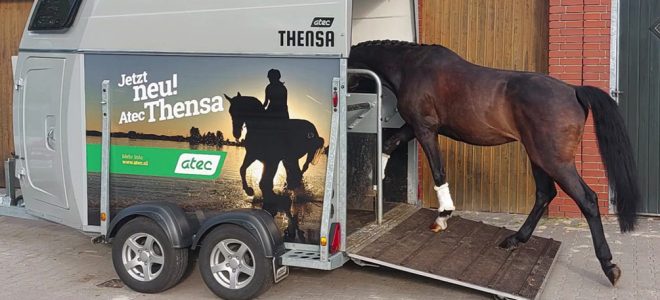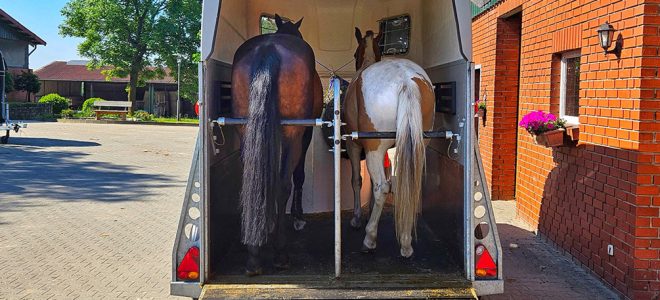Load horses wisely
Does your horse rear up in front of the trailer, stop or run past the horse trailer? Loading can be so easy and should work without any compulsion. We have put together a few tips for you, so that your horse can be loaded without any problems.
1. First stage: the preparations
It is very important to make sure your horse trusts you and the communication between you harmonizes perfectly. Therefore, you should not even deal with the loading itself in the beginning, but work with your horse from the ground. Important lessons here would be leading, standing still, backing up or sending sideways. If these lessons are implemented well, you can begin to send the horse through tighter spaces, such as between yourself and the wall. Of course, all lessons must be worked out step by step and, if necessary, analysed where and why there are communication problems.
2. Keep calm
When dealing with loading horses, you must remain calm in every situation. It is important that you are able to control your own emotions and always convey a calm feeling to the horse. As soon as you build up tension with your body language, this tension is immediately transferred to your horse. Take a deep breath, let your horse feel that there is no danger and be physically and mentally relaxed for your horse.
3. Important tools
There are a few important tools to keep on hand while loading your horse. This includes a long riding whip/stick, a lunge and a well-fitting halter. Other tools are, of course, body language and voice.
Of course, you should always use all tools thoughtful and respectful. You always have to distinguish whether the horse is angry or frightened. If you punish a fearful horse additionally for example, it would have severe negative consequences for the horse’s trust and it would become even more insecure. So what is the best way to use these tools?
Body language/voice: Do not look directly at your horse, but always keep your gaze in the trailer or away from the horse. If you turn your gaze/body towards the horse with tension, this signals a rearward movement. Once the horse has shown something positive, use your voice to praise the horse and relax your body to release any tension for the moment. For example, you can take a deep breath and let your shoulders drop.
Riding whip/stick: The crop or a stick is a good tool to use as an extended arm to reach the horse’s hindquarters. This tool should already be included in the ground work so that your horse has a secure feeling with it, instead of being afraid. It is very important not to punish the horse with the riding whip, if it does not “obey”. With a lot of calm energy, it is usually sufficient to tip the horse a little bit and ask it to take a step forward. If it doesn’t respond, try increasing the intensity a bit. A tap becomes a knock and a knock becomes a short pulse. As soon as the horse responds, immediately relax and praise the horse.
Lunge: The lunge serves as a support if your horse needs a little more security or wants to walk past the trailer to the side. To use the lunge properly, it should be attached to the side of the trailer and kept taut by a helper to the back. As soon as the horse wants to move sidewards, a short impulse should come from the lunge and the horse realizes that it cannot go past this line. Some horses, for example young and inexperienced horses, still need the security of two lunges, which are attached to the left and right of the trailer.
4. The trailer
The new Atec Thensa combines everything a horse needs to be loaded ideally. With the flat entrance and the bright, spacious interior, with dimensions of 3.50 m in length, 1.75 m in width and a very striking height of 2.40 m, the horses feel completely at ease.

The floor of the horse trailer consists of two-layered plastic composite panels, which are aluminium-coated at the top and bottom. This makes the floor incomparably strong, so that even the heaviest horses can be loaded without complications. With the hydraulic support system, opening and closing the tail-door ramp is easy and can be operated by anyone with one hand. Furthermore, the tail-door ramp is equipped with anti-slip rubber and cross step bars. Your horse will always have sufficient grip. The front and rear panic safety system also protects against injuries in dangerous situations by allowing the bars to be unlocked quickly and easily from the outside.
Atec means comfort, safety and fulfilment. With the Atec horse trailer, the company wants to help the horses to relax during the transport with optimal light incidence and air circulation. With a clear goal of offering horses the perfect transport solution and at the same time guaranteeing ideal driving comfort, the high-quality Atec horse trailers are the best choice. Horse and owner will always reach their destination safely and carefree. It doesn’t matter whether it’s an experienced, young or problematic horse, whether it’s a mare with a foal or a stallion – the Atec horse trailers always give you a good and safe feeling.
5. Safety first
Before you really start with the loading training, make sure that all sources of danger have been eliminated. Is the horse trailer in a perfect condition and coupled correctly to the car so that the horse can be loaded? Are the tailgate levers properly pushed under the ramp? Do you wear gloves, so you don’t get injured if your horse tries to get out of the situation? You should ask yourself all these questions before you want to load the horse. In addition, you can open the door at the front to bring more light into the trailer and also unhook the bars or build one box wide to give the horse a little more space. Your horse should also be properly protected during transport with the help of boots/transport boots.
6. The approach
Before you load the horse onto the trailer with a ” quick move”, you can start to approach it a little so that the horse gets to know the trailer and realizes that it is not dangerous. You can tell the horse to touch the side of the horse trailer with its nose for example. You can also let the horse run sideways over the flap. This is how you get the first confidence in relation to the trailer without directly overtaxing the horse.
7. Loading
You can now slowly approach the trailer. If you notice your horse is hesitating, incorporate ground work elements and keep your horse occupied so that it is fully focused on you. Walk, stay, walk, reverse. Put one leg on the flap, turn backwards and away from the trailer again. Next time, go a little further up the trailer and increase your achievements step by step. Of course, depending on the horse, you have to look individually where the problems occur and how to use the mentioned tools accordingly. At the same time you have to analyse, if there are still communication problems and work to be done in the ground work.

Do not tie the horse until the rear bar is closed, no matter how experienced or inexperienced the horse is. If the horse is startled and runs backwards while it is already tied, this can lead to serious injuries in the neck area. Therefore first close the safety bar at the back and then tie the horse to the front. The same procedure goes for unloading. First open the rope and then remove the pole. Finally unload the horse with calm and serenity.
If everything works out, it’s time for practice, practice and more practise. Because not only riding, but also a calm and relaxed loading can only be learned through routine.


